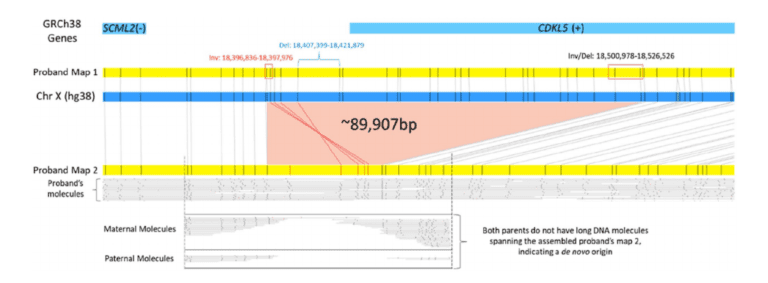Blog
Optical Genome Mapping Detects Disease-Causing Variants in Two Rare Disease Cases, Ends Exhaustive Diagnostic Odysses
Two recent publications in peer-reviewed journals demonstrate how researchers used optical genome mapping (OGM) with the Bionano Saphyr® system to identify disease-causing variants in children with rare diseases.
In a publication in Molecular Genetics & Genomic Medicine, a team of scientists and clinicians from Duke University, Children’s National Hospital, Mayo Clinic and Columbia University Medical Center presented the case of a four-year-old boy with uncontrolled epilepsy, visual impairment, muscle weakness and severe developmental delay. Extensive metabolic and genetic testing had been non-diagnostic, including karyotyping, chromosomal microarray, a 38-gene epilepsy panel, mitochondrial genome sequencing, and exome sequencing followed by whole genome sequencing of the child and his parents. All these methods were negative, no variants were reported.
Optical genome mapping with Saphyr immediately identified the disease-causing variant: a never-before-reported mosaic deletion of 90 kbp next to a smaller inversion on the X chromosome overlapping one gene, CDKL5. The deletion occurs in only about 24% of the cells, which is likely why all sequencing-based methods failed to detect it. Since OGM is a single molecule analysis technology, both the normal and the variant allele were easily identified.

This paper stands out not just because of how it illustrates the exhaustive diagnostic odyssey that so many patients and families have to go through, but it also marks the first OGM publication from the Undiagnosed Diseases Network (UDN), a nationwide research study funded by the National Institutes of Health. The UDN aims to discover diagnoses for the most difficult-to-diagnose individuals (including many with non-diagnostic array and sequencing results) through collaborative science and adoption of novel diagnostic methods. And while Saphyr is a research-use-only platform, results generated in a research setting can be confirmed with a validated clinical test such as PCR, digital or quantitative PCR or Sanger sequencing.
In a second publication, in the journal JID Innovations, a team from Dalhousie University in Nova Scotia, Canada presented the case of a family with Basan Syndrome, an extremely rare genetic disorder marked by the absence of fingerprints, inability to sweat (which increases the risk of heat strokes), and various skin lesions. Since it was first characterized in 1964, only 10 families with this disease have been identified around the world.
In the Canadian family, targeted sequencing of the suspected candidate gene and trio exome sequencing failed to identify disease-causing variants. OGM with Saphyr detected a 28 kb deletion in the SMARCAD1gene, and further sequencing and PCR analysis found a deletion flanking an inverted duplication. The paper also describes a Dutch family studied with whole genome sequencing by a Dutch team.
We continue to see how our optical genome mapping technology helps researchers understand rare and poorly understood diseases, provide answers and end years-long diagnostic odysseys



